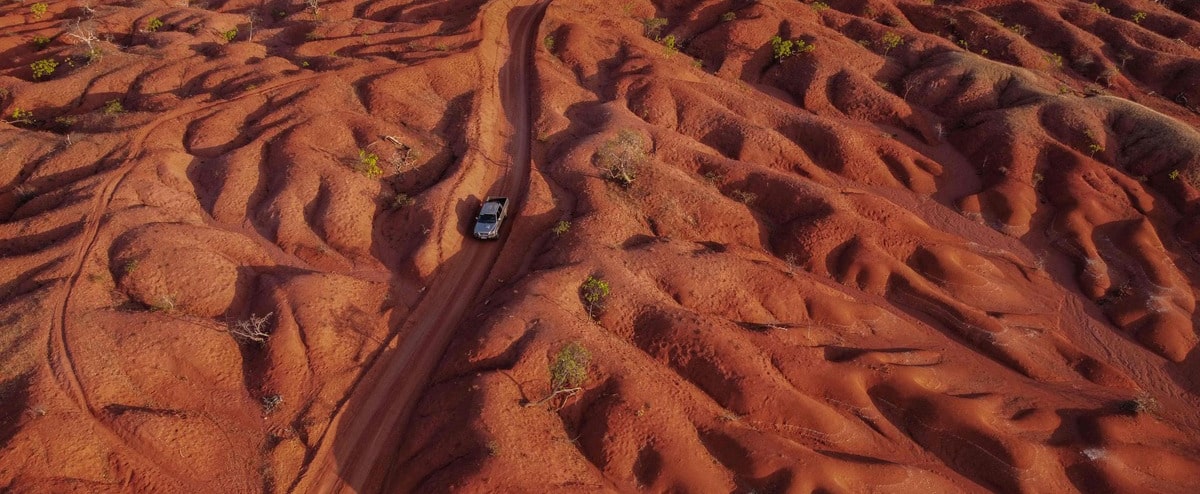You could call it a lunar landscape, but since the cracked earth is red, it seems to come straight from the planet Mars. Welcome to the region of Gilbués, a municipality in the northeast of Brazil where desertification is advancing rapidly.
• Read also: World heading ‘in the wrong direction’ to stop deforestation by 2030
• Read also: Extreme drought in the Amazon: ancient engravings are revealed at the bottom of the rivers
Only a few small shrubs with yellowed leaves remain in the middle of these hilly lands as far as the eye can see which now extend over an area larger than the city of New York, swallowing up farms and homes.
According to experts, erosion of the already naturally fragile soil in this area of Piaui state has been greatly accelerated by deforestation and other human activities.
AFP
But a few hundred farming families continue to fight to preserve a few oases in the middle of the “Gilbués desert”.
“Everything is out of control. It no longer rains like before,” laments Ubiratan Lemos Abade, a 65-year-old breeder who is trying to keep his fifteen cattle alive despite the extreme drought.

AFP
“Here, you have to irrigate to get by, otherwise (…) all our land would have died of thirst,” he explains, pointing to a pasture of lush grass that stands out in the middle of the red desert.
He set up a makeshift watering system himself, digging a well connected to a network of pipes.
“Here, you need technology to do agriculture. But when you are poor, it’s complicated,” he sighs.

AFP
“Fragile Earth”
Seen from the air, the landscape looks like a gigantic, crumpled sheet of bright red sandpaper.
The erosion problem is not new. One of the hypotheses of the origin of the name “Gilbués” is an indigenous term which means “fragile earth”, explains Dalton Macambira, environmental historian from the Federal University of Piaui.
But human activities have greatly worsened the situation, razing or burning native vegetation whose roots helped give more consistency to the soil.

AFP
Not to mention the urban expansion of Gilbués, which has become a town of 11,000 inhabitants.
This town experienced a diamond rush in the middle of the last century, before the sugar cane boom in the 1980s.
Today, it is one of the largest soy producers in Piaui.
“These activities are accelerating the problem, with unsustainable natural resource requirements for this type of environment,” warns Mr. Macambira.
In January, he published a study showing that the area affected by desertification more than doubled from 1976 to 2019, from 387 to 805 km2.

AFP
Around Gilbués, 14 other municipalities in the region are affected and some 500 farming families are affected.
Climate specialists believe that further studies are necessary to determine with certainty whether global warming is also a factor in accelerating this desertification.
Local farmers report that the dry season is getting longer and longer.
During short periods of rain, precipitation is more intense, which makes the situation even worse: the ground is so fragile that the deluge creates huge craters, known as “voçorocas”, which engulf fields and homes. .
“Wherever the environment is degraded, climate change tends to have more perverse effects,” summarizes Dalton Macambira.

AFP
Potential
Described as a “silent crisis” by the United Nations, desertification affects 500 million people worldwide.
But Fabriciano Corado, president of the SOS Gilbués association, still sees strong potential in his region.
If we can preserve it from erosion, clay soil rich in phosphorus is every farmer’s dream: to cultivate it, there is no need for fertilizer.
According to him, small producers like Mr. Abade have managed to make their farms survive by protecting native vegetation, implementing drip irrigation systems or traditional terrace cultivation techniques to better resist erosion.
“We did not invent gunpowder, the Aztecs, the Incas and the Mayans were already doing the same thing,” recalls Mr. Corado, who strongly criticizes the closure six years ago of a public research center which helped the farmers to implement these techniques.
Local authorities assure that they intend to reopen it, but without giving a precise date.
The region also has strong potential for solar energy production: a huge park with 2.2 million panels was recently inaugurated and another is on track.
